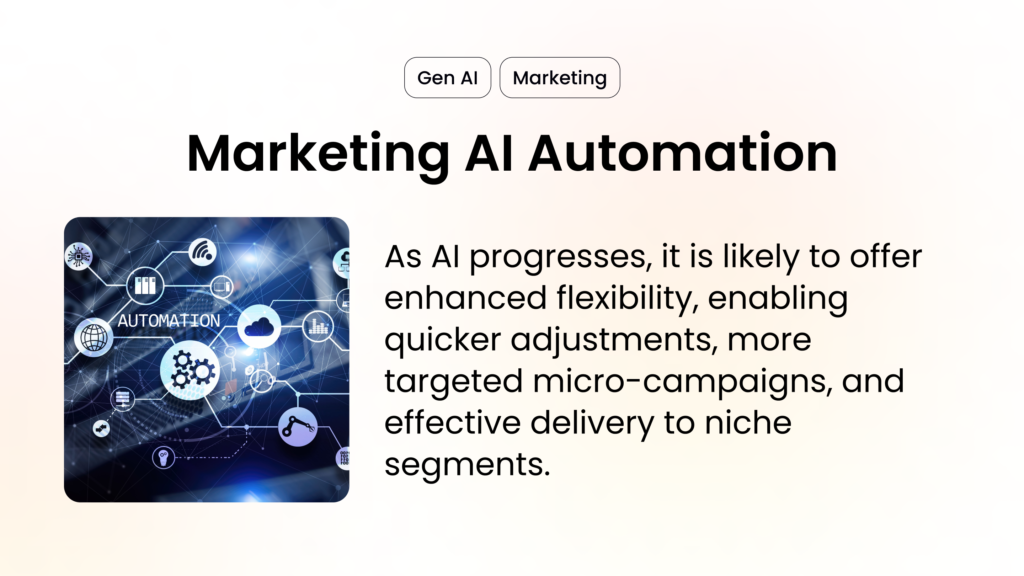Being released just a year ago, Generative AI (Gen AI) has swiftly transitioned from an emerging technology to an essential asset, transforming the methodologies employed by marketing professionals.
This technology is poised to drastically alleviate workloads, whilst concurrently optimizing both time and financial resources, thrusting the marketing sector into an era of limitless potential. As the growth and change of AI show no signs of slowing down, marketing professionals must stay ahead of the curve and understand how Gen AI will continue to shape the future of marketing in 2024.
1. Enhanced Precision in Ad Targeting
The evolution of Gen AI heralds a new era in ad targeting, enabling marketers to harness sophisticated algorithms that analyze vast datasets with unprecedented precision. This means ads can be tailored to the viewer’s current mood, recent purchases, and even nuanced interests.

With the use of Gen AI, marketers can run more accurate ads. However, this also sets a higher bar for what constitutes a successful ad, requiring marketers to focus on quality and ensure that the ads aren’t missing the mark.
Your next step in marketing:
The widespread adoption of AI for ad targeting raises a critical question: Will consumers become more discerning and critical of ads?
Leveraging AI for better targeting isn’t mandatory at this moment. But it’s important to consider that consumers might scrutinize ads more closely and demand even more polished messaging.
Monitor your ad performance more diligently and experiment with A/B testing to ensure your messaging is as precise as it can be.
2. Improved AI Marketing Automation
Marketing automation is gaining momentum, encompassing everything from automated email dispatches to programmatic advertising. As this technology progresses, it is likely to offer enhanced flexibility, enabling quicker adjustments, more targeted micro-campaigns, and effective delivery to niche segments.

The rise in AI-driven marketing automation may lead to changing audience expectations. Consumers might start to anticipate quicker campaign turnarounds, finer audience segmentation, and even more personalized content.
Your next step in marketing:
Incorporate the shifts in audience demand into your content creation process as you plan your campaigns for the next few quarters. Using AI-driven automation, you can integrate smaller campaigns into your strategy.
Consider any potential challenges or subjects you could address with these efforts. Think about how automating the scheduling of social media posts or email dispatches could give you more time to dedicate to other projects.
3. Enhanced Chatbot Abilities
Today’s chatbots are not just for capturing leads; they’re excellent at it, but they offer so much more. They can engage in complex conversations, comprehend context, and deliver personalized customer service 24/7.
With the ability to answer nuanced questions about products and services, chatbots can now guide visitors through your website and along the sales funnel with greater efficiency.
As these technologies continue to evolve, adopting sophisticated chatbots will become a strategic move for many companies. Doing so not only places you ahead of the curve but also strengthens your competitive edge in the market.
If you haven’t considered deploying an advanced chatbot yet, now is the perfect time to explore this technology and secure your position in a rapidly changing business environment.
Your next step in marketing:
Improving customer satisfaction through quick and accurate solutions to their questions is crucial. Furthermore, analyzing these interactions provides businesses with critical insights, guiding future product and service enhancements.
Consider the content strategy for your chatbot, focusing not only on its responses but also on directing users to relevant content on your site based on their queries.
Regularly review your chatbot interactions to identify common questions and assess if users are finding the help they need. If information gaps are discovered, create content to address these areas, allowing your chatbot to better fulfill user needs.
4. More Use of Predictive Analytics
Predictive analytics uses Gen AI to analyze past customer data, enabling marketers to accurately forecast market trends and consumer behavior. Although not a new technology, its effectiveness is increasing annually.
As AI technology advances, it’s expected that predictive analytics will enhance, offering more precise forecasts, improved product suggestions, and beyond. For instance, sophisticated predictive analytics techniques will enable businesses to predict sales outcomes. Therefore, businesses can determine the potential performance of items with specific audiences and conditions, and identify which products could excel in marketing campaigns.
Your next step in marketing:
Equipped with the right historical customer and site data, organizations can significantly enhance their predictive analytics capabilities. It’s essential to start gathering the necessary data immediately, regardless of whether you’re currently using predictive analytics.
By doing so, you ensure that when you do find the perfect predictive analytics solution for your business, you’ll have a wealth of historical data ready to leverage, setting you up for immediate success.
5. Improved Research and Decision-Making
Gen AI in Marketing provides businesses with state-of-the-art tools for comprehensive market research and analysis, enhancing the decision-making process by making it more reliant on data and reducing the likelihood of human error.
Advanced AI is adept at supporting a wide array of marketing research tasks, ranging from answering immediate queries about content topics to swiftly detailing the performance of different tools.
This capability allows smaller companies to accelerate their research processes, make decisions based on solid information, and swiftly evaluate the variety of tools they are considering. This advanced assistance not only streamlines operations but also empowers businesses to navigate their marketing strategies with greater accuracy and efficiency.
Your next step in marketing:
Expect AI to further enhance its abilities in 2024, leveling the playing field for smaller companies to compete with industry giants. This is beneficial for those managing lean teams.
However, it also signifies that competition will intensify. It’s crucial to familiarize yourself with AI tools such as ChatGPT and Jasper to streamline marketing research processes and avoid lagging. Remember, prioritizing quality and verifying facts obtained from any AI tool remains paramount.
6. Ongoing Growth in Voice-Assisted Shopping
As AI progresses, so does the potential of voice-based search. The era when voice commands were used solely for seeking answers to queries like, “How do I know when the cheese in the back of the fridge is bad?” is over.
The rising trend in voice-based shopping and searching will probably push marketers to increasingly focus their strategies on the voice-based experience. Soon, voice-based payments and shopping will become the standard expectation.
Your next step in marketing:
To capitalize on this trend, marketers must refine their strategies, making sure their offerings are easily found through voice search, thereby accessing an expanding market niche. Focusing on creating content around longer-tail keywords likely to be used in voice queries is crucial.
While Voice SEO is on some companies’ agendas, it’s not on everyone’s yet. Developing content optimized for voice search today will position you advantageously as AI continues to enhance voice-driven shopping and searching experiences.
7. Increased Utilization of Multimodal AI
Multimodal AI merges various inputs such as text, visuals, and audio to offer a richer experience, distinguishing it from AI systems that only use one type of input. Generative AI, which can produce both content and visuals simultaneously, is a key instance of multimodal AI’s capabilities.
Your next step in marketing:
Regardless of your current use of multimodal AI, it’s likely that your competitors are already leveraging it. Consider utilizing generative AI to generate content ideas and provide your team with starting points. However, it’s crucial to implement a screening process to avoid the release of uninspired, AI-produced content.
The bottom line
The future of marketing AI is not just on the horizon, it’s here, bringing with it a wave of innovations set to transform the industry. With each advancement, Gen AI empowers marketers to reach new heights of creativity, efficiency, and effectiveness.
Whether you’re a tech enthusiast, business owner, or marketer, staying abreast of these trends is crucial to harnessing the full potential of AI in crafting campaigns that captivate and convert. The future is now, and it’s automated, personalized, and smarter than ever.





